In recent years, inflatable paddle boards have gained popularity among water sports enthusiasts.
Paddle boarding is a delightful sport that offers a range of benefits, such as improving balance, burning calories, and providing an opportunity to reconnect with nature.
As the interest in paddle boarding grows, so does the curiosity about the effectiveness of blow-up paddle boards.
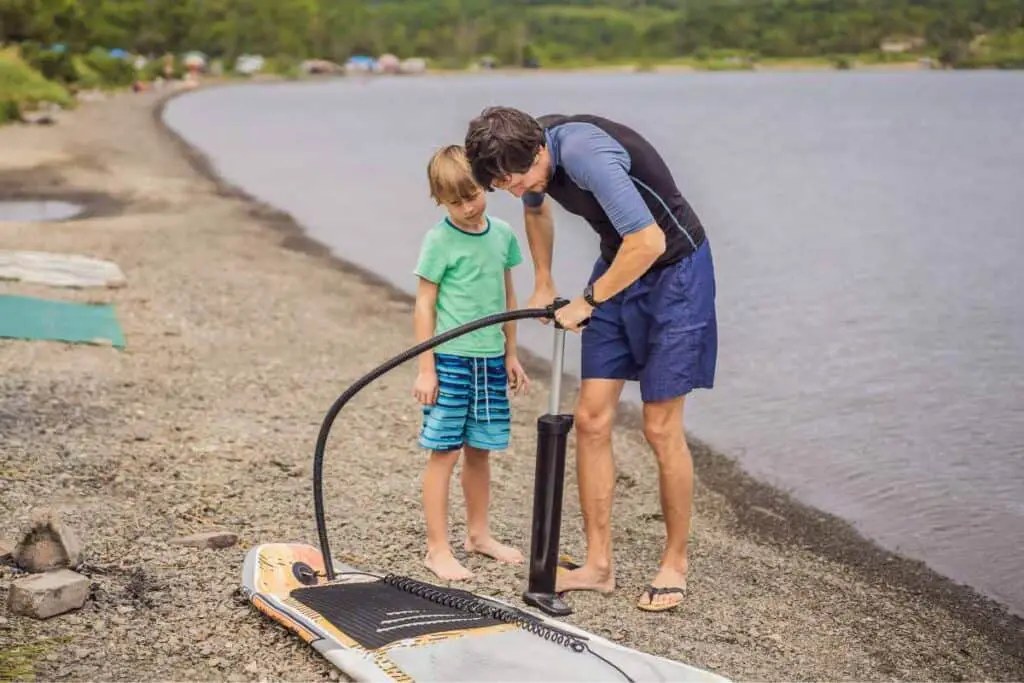
One of the primary concerns for potential buyers is the quality and performance of these inflatable boards. Fortunately, inflatable paddle boards have proven to be quite reliable and efficient in the water.
These boards provide several advantages over their traditional hard counterparts, such as portability, easy storage, and overall stability.
Due to their wider construction, inflatable paddle boards can be especially beneficial for beginners looking to learn the sport or for those interested in participating in activities that require a stable platform.
In summary, blow-up paddle boards are an excellent choice for anyone looking to engage in paddle boarding, whether they are beginners or experienced enthusiasts.
The innovative technology used in manufacturing these boards ensures their durability and performance, enabling users to enjoy the sport without sacrificing quality or stability.
Understanding Paddle Boards
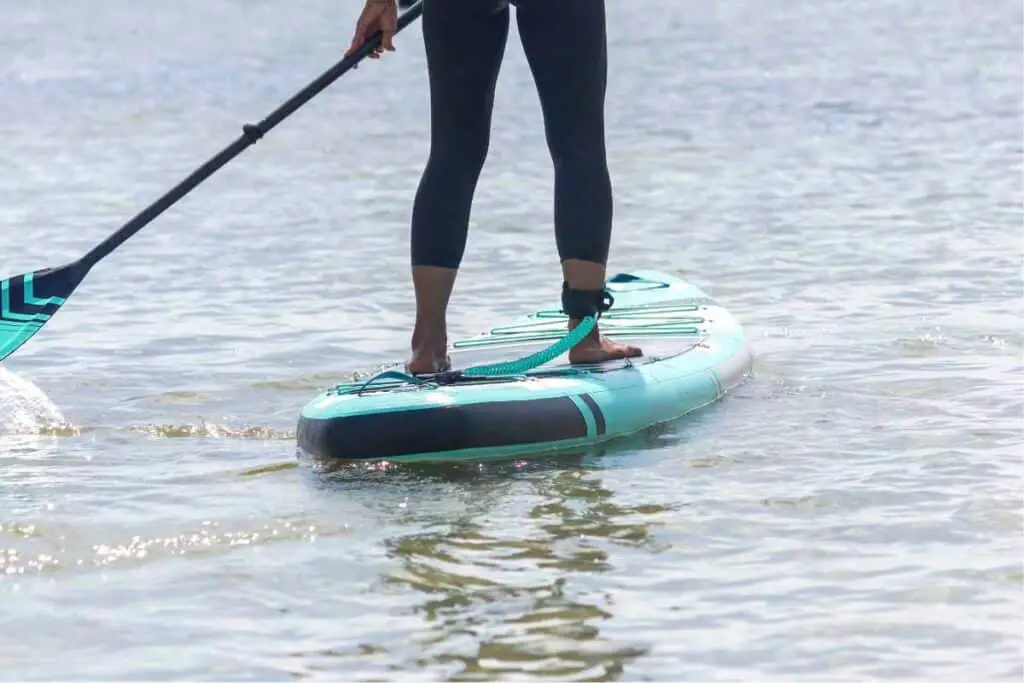
Paddle boarding is a versatile and enjoyable sport that allows individuals to connect with nature while maintaining a healthy lifestyle.
These boards come in various designs and materials, catering to different skill levels and preferences. This section will explore the differences between rigid and inflatable paddle boards, their areas of usage, and who can benefit from using them.
Differentiating Rigid and Inflatable Boards
Rigid paddle boards, made from sturdy materials like fiberglass, carbon fiber, or plastic, offer a solid and stable experience on the water.
On the other hand, inflatable paddle boards (sometimes called blow-up paddle boards) are constructed using durable PVC material that can be deflated and rolled up for easy transport and storage.
Inflatable paddle boards have become increasingly popular due to their durability, performance, and affordability, making them an ideal choice for beginners.
While inflatable boards generally provide more stability, they may be more affected by wind and waves due to their lighter weight and higher profile. However, this may be mitigated by improving balance and technique.
Area of Usage for Paddle Boards
Paddle boards can be used in various water conditions, from calm lakes to choppy oceans and rivers.
When paddling on a lake or river, both rigid and inflatable paddle boards can be suitable options. However, for ocean and beach settings, where the water is more unpredictable, a rigid paddle board may provide better control and stability.
Regardless of the location, choosing the right paddle board is essential for optimizing performance and ensuring safety. It’s important to consider factors like board size, weight capacity, and design based on the specific conditions of the area where the sport will be practiced.
Who Can Use Paddle Boards
Paddle boarding is an accessible sport for people of all ages, including kids, beginners, and advanced practitioners.
Children can use smaller, lighter paddle boards designed specifically for their size and skill level. Beginner paddle boarders may find inflatable boards a more suitable option due to their stability and affordability.
Meanwhile, advanced paddlers may lean towards rigid boards for increased performance and maneuverability.
In conclusion, both rigid and inflatable paddle boards offer unique advantages, catering to different preferences and skill levels. The choice ultimately depends on factors such as area of usage, personal preference, and skill level.
Advantages of Inflatable Paddle Boards
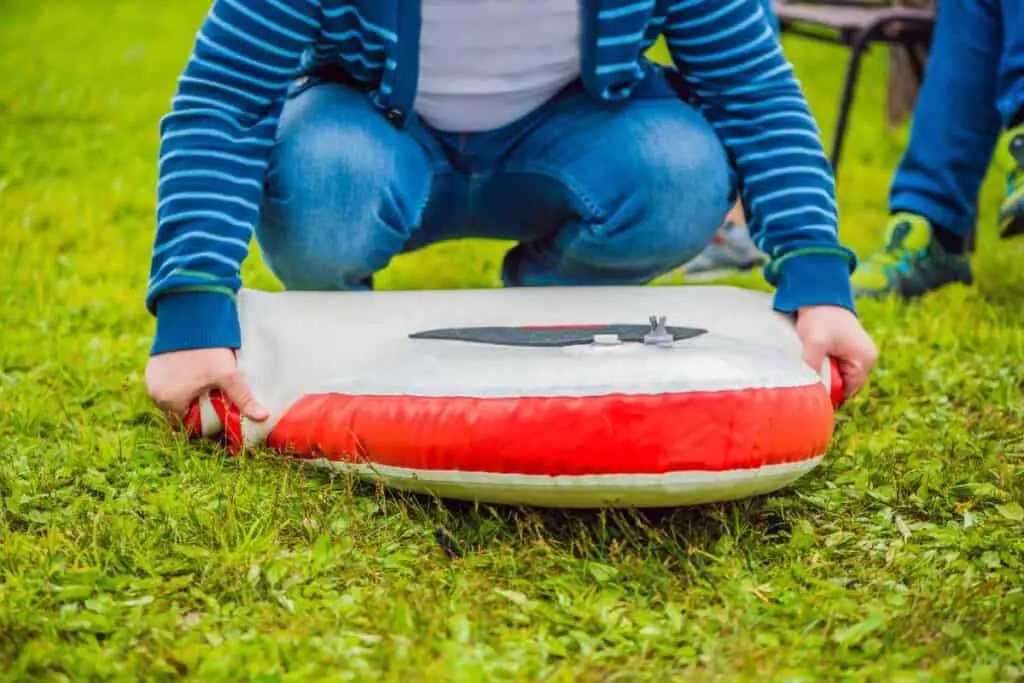
Portability and Transport
Inflatable paddle boards, also known as blow up paddle boards or iSUPs, are remarkably portable.
They can be deflated and rolled up into the size of a large backpack, making them much easier to transport compared to hard paddle boards.
This means there is no need for car roof racks, allowing users to carry them even in compact vehicles or public transportation. In addition, inflatable paddle boards are easy to store even in limited spaces when not in use.
Stability and Maneuverability

Inflatable SUPs (Stand-Up Paddleboards) offer an excellent balance between stability and maneuverability.
Their soft material provides a stable surface for beginners, while the rigid and solid build allows for smooth maneuvering in the water.
Furthermore, falling onto an inflatable paddle board is a significantly softer impact compared to a hard board, making it an ideal choice for beginners and those who want extra safety.
Size and Weight Capacity
Inflatable paddle boards come in a wide range of sizes, generally between 8 to 16 feet in length. Most beginners and intermediate paddlers prefer a board in the 10 to 12-foot range.
As for weight capacity, inflatable SUPs are usually lightweight yet incredibly durable, with the ability to support the weight of adult users and even their furry companions (dogs).
Thickness plays an essential role in inflatable boards, as it relates to how well the board floats and supports the user.
Find out – Do Sharks Eat Dogs?
Water Activities with Paddle Boards
Inflatable paddle boards are ideal for a variety of water activities, such as yoga, fishing, and surfing.
The soft surface benefits yoga enthusiasts seeking a gentle and stable platform, and anglers can appreciate the stability and maneuverability for fishing.
Although hard paddle boards are still preferred for racers and enthusiasts, inflatable SUPs have gained popularity in the whitewater paddling community due to their excellent durability and performance.
Comprehensive Review of Inflatable Paddle Boards
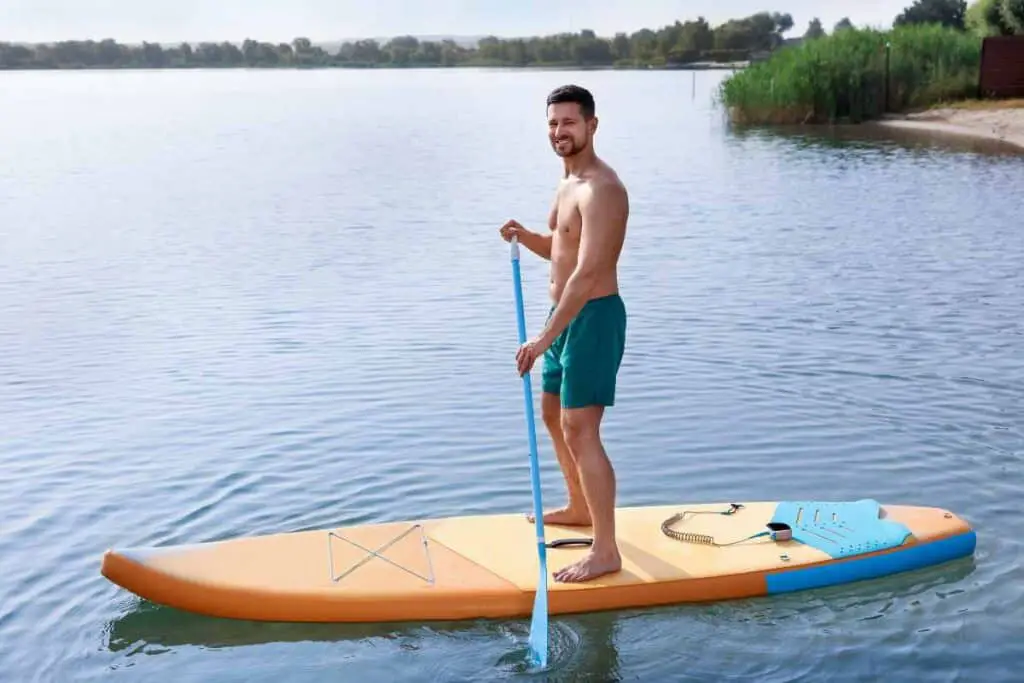
In this section, we will delve into a comprehensive review of inflatable paddle boards.
We will discuss standout brands and models, essential accessories and features, and special designs for specific uses.
Standout Brands and Models
Inflatable paddle boards have gained popularity in recent years due to their portability, stability, and durability.
Some of the leading brands in the industry include:
- ROC: Known for producing high-quality and beginner-friendly inflatable paddle boards.
- Bluefin: The Bluefin Cruise Carbon series is popular for its performance and rigid structure.
- ISLE: Offers a wide variety of inflatable paddle boards suitable for different skill levels and water conditions.
- Red Paddle Co: A well-respected brand known for the use of innovative materials and designs.
Each of these brands offers different models catering to various skill levels, water conditions, and personal preferences.
Essential Accessories and Features
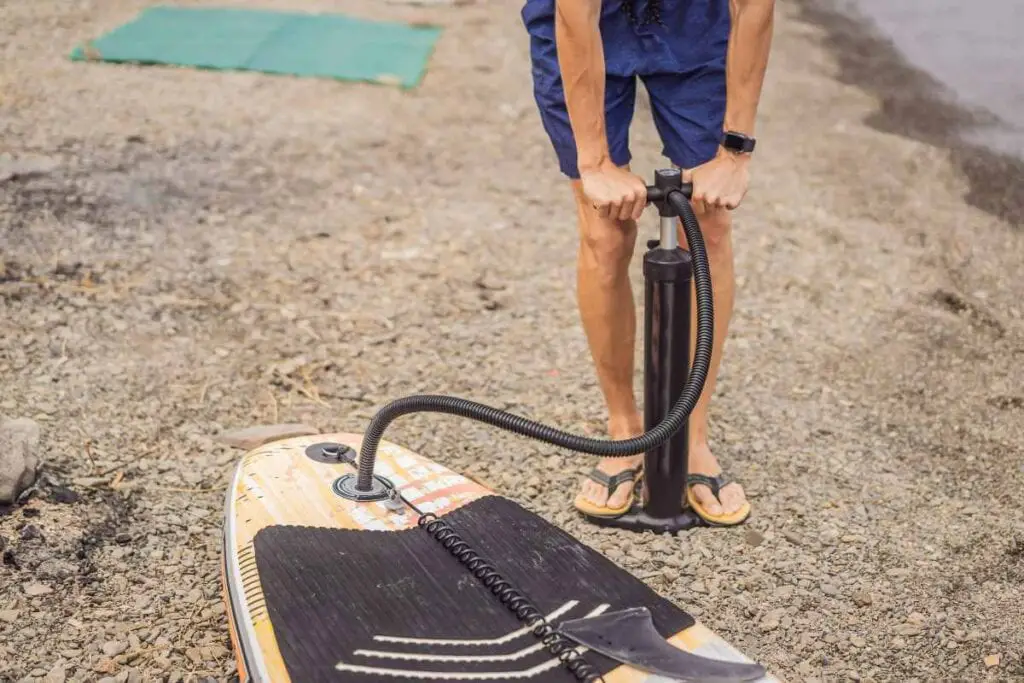
Equipping your inflatable paddle board with the right set of accessories is crucial for optimal performance and safety.
Some essential accessories and features to consider include:
- Pump: A high-quality pump is necessary for inflating and deflating the board effectively.
- Paddle: Ensure the paddle is adjustable, lightweight, and comfortable to use for extended periods.
- Fin: A removable fin can help enhance the stability and maneuverability of the board.
- Leash: A safety leash is essential for keeping you connected to the board in case of a fall.
- D-rings and cargo system: Multiple D-rings and a cargo system allow you to securely attach gear and personal items to the board.
Besides the accessories, the size and thickness of an inflatable paddle board are significant factors affecting its performance.
Generally, a 10 to 12-foot board is suitable for most beginning and intermediate paddlers. A thicker board can provide better stability, especially for beginners.
Special Designs for Specific Use
Inflatable paddle boards come in various designs tailored to specific uses.
Some common designs include:
- Yoga: Specially designed yoga paddle boards offer a stable and wider deck surface, providing sufficient space and comfort for practicing yoga poses. Find out more about yoga for surfers.
- Fishing: Fishing paddle boards have extra features such as attachment points for fishing gear, rod holders, and a larger cargo area.
- Touring: Touring boards typically have a pointed nose and a longer shape, making them suitable for traveling long distances in various water conditions.
- Surfing: These boards are designed for more experienced paddlers, offering increased maneuverability and responsiveness in waves.
- Whitewater: Whitewater paddle boards are built with added durability and stability to withstand rough water conditions.
In conclusion, inflatable paddle boards have proven to be a reliable, portable, and versatile option across various skill levels and water conditions.
Considering the brands, accessories, and designs discussed, paddlers can find the perfect inflatable paddle board to suit their specific needs.
Maintenance of Inflatable Paddle Boards
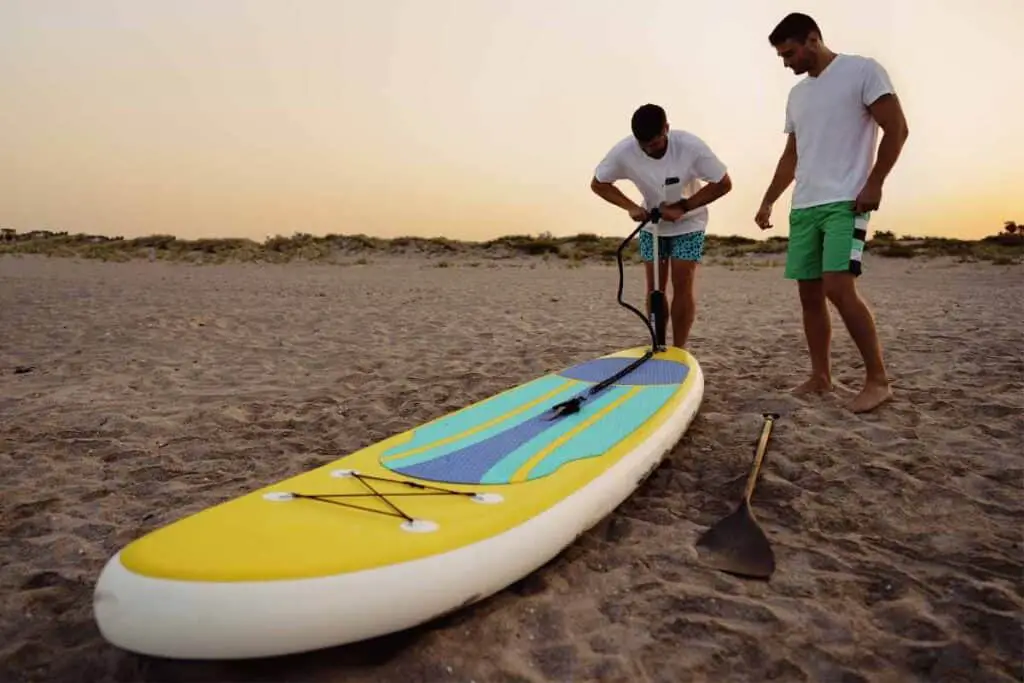
Inflation and Deflation
Inflatable paddle boards are designed for easy inflation and deflation, often using manual or electric pumps.
It is crucial to maintain the appropriate air pressure during use, as specified by the manufacturer. Overinflating can cause damage to the board’s construction, while underinflating may compromise its stability and performance.
Remember to release air from the board by opening the air valve after each use, making sure to follow the manufacturer’s guidelines for safe deflation.
Handling and Storage
Proper handling and storage of your inflatable paddle board can extend its lifespan and preserve its functionality.
- When not in use, store the board in a cool, dry place, away from direct sunlight or extreme temperatures. Sunlight can degrade the PVC material, while fluctuating temperatures may cause damage to the board’s seams.
- When transporting your paddle board, consider using a carrying bag or case to protect it from scratches and potential punctures. Securely attach any additional accessories, such as leashes and D-rings, to prevent loss or damage.
Repair and Longevity
Inflatable paddle boards are designed with durability in mind, often lasting for years with proper care and maintenance. Despite their resistance to wear and tear, punctures or leaks might still occur.
In such cases, it’s essential to have a repair kit on hand, which usually includes patches, glue, and a valve wrench.
Regularly inspect your board for any signs of damage and promptly address any issues to ensure its longevity. Moreover, using a protective spray like the 303 protective spray is recommended to further preserve your board’s material.
Safety Precautions
Inflatable paddle boards offer stability and comfort, but it’s essential to prioritize safety when using them.
Always wear the appropriate safety gear, such as a life jacket and helmet, particularly in challenging water conditions.
Furthermore, maintain the board’s tether or leash to minimize the risk of separation. Examining your board for any signs of damage before each use can prevent complications on the water.
Adhering to these safety practices, along with proper maintenance and handling, will ensure a worthwhile and enjoyable paddle boarding experience.
Choosing the Best Inflatable Paddle Boards
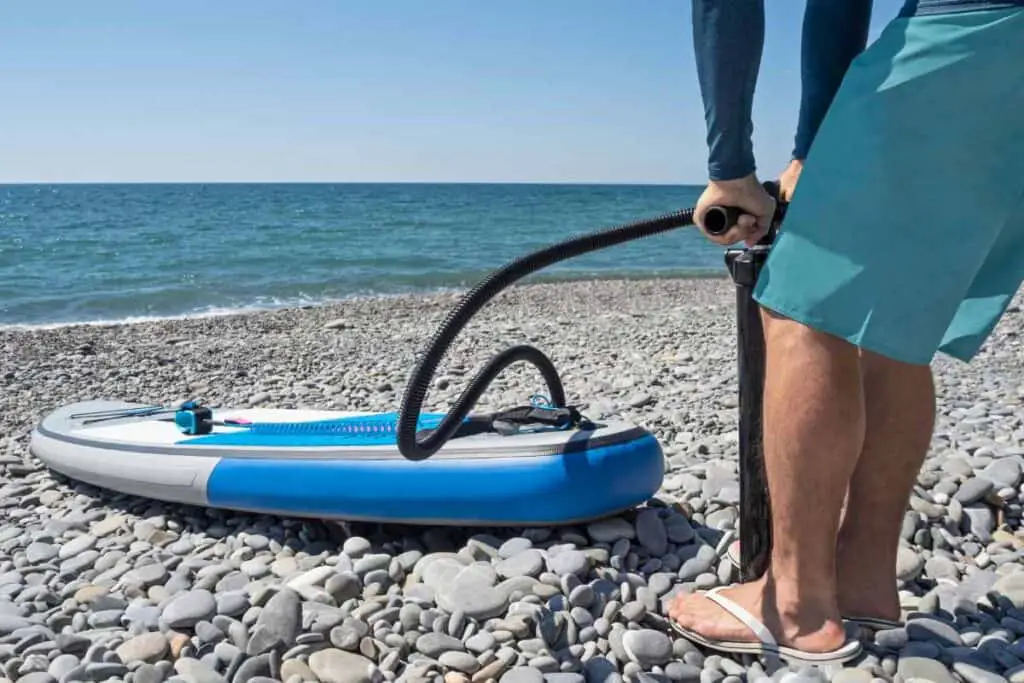
Factors to Consider According to Skill Level
When selecting an inflatable paddle board, it’s essential to consider your skill level. For beginners, stability and ease of maneuvering are crucial factors.
Look for boards with a wide and stable design, as they tend to be more comfortable for new riders.
On the other hand, advanced paddlers may prioritize speed and performance, opting for narrower and longer paddle boards.
Importance of Cost and Value for Money
Cost plays a vital role in choosing an inflatable paddle board. A variety of options are available on the market, ranging from budget-friendly to premium models.
When considering cost, it’s essential to keep in mind not just the initial investment but also the value for money.
Look for paddle boards that are durable, lightweight, and portable, while offering a good balance between affordability and quality.
Versatility and Ease of Use
An inflatable paddle board should be versatile and easy to use. It should be easy to inflate, deflate, and carry, making it convenient for a variety of paddling experiences.
Consider boards with an efficient and user-friendly pump system to save time and effort.
Additionally, some paddle boards offer versatile options such as attachments for kayak seats, allowing for multi-functional use.
Capacity and Special Needs
Weight capacity and storage space are crucial factors to look into.
Always check the board’s maximum weight capacity, especially if you plan to have multiple riders, dogs, or extra gear on board.
Boards with higher weight capacities will cater to a wider range of riders and needs. In addition, consider boards with ample storage space and attachment points for accessories such as dry bags, fishing gear, and more.
Investing in Suitable Accessories
Accessories are an essential part of the paddling experience and play a significant role in enhancing your inflatable paddle board outings.
Key accessories to invest in include:
- an efficient pump
- a sturdy leash
- a reliable and comfortable paddle
- and a durable dry bag for storing belongings
Consider additional accessories such as a kayak paddle and seat, which provide added versatility and convenience depending on your preferences and intended use.
Frequently Asked Questions
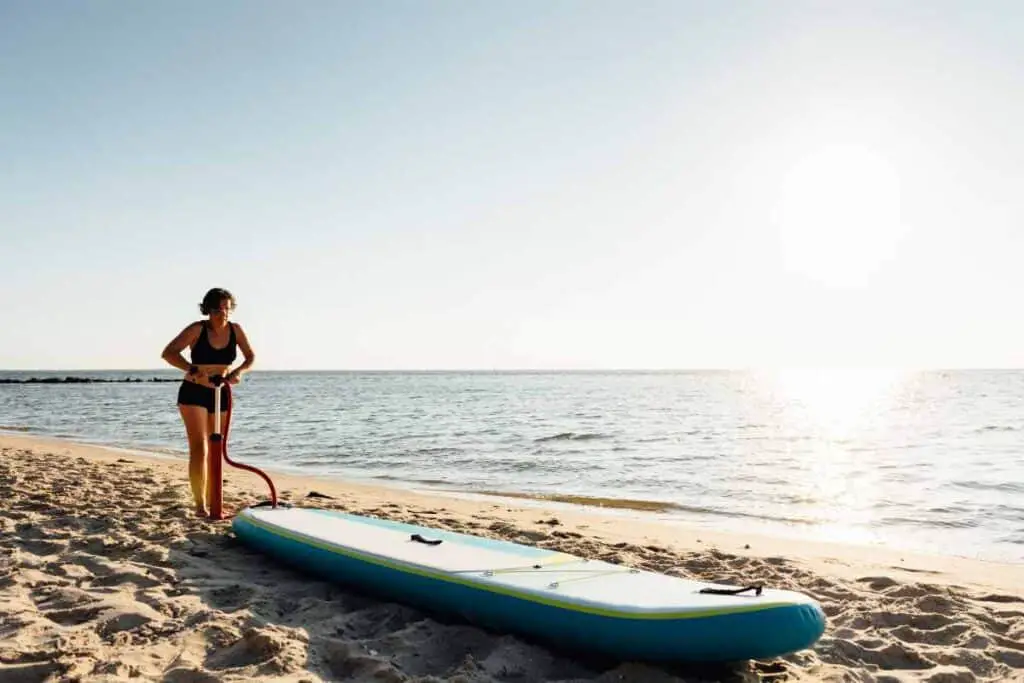
Are inflatable paddle boards durable?
Inflatable paddle boards are made from durable materials such as PVC and drop-stitch technology, which allows them to be inflated to a high pressure and maintain their shape even when in use. These materials make inflatable paddle boards highly durable and able to withstand various conditions in the water.
What are the drawbacks of using inflatable paddle boards?
While inflatable paddle boards have many advantages, some drawbacks include their tendency to be less rigid than solid paddle boards, which can affect performance when it comes to maneuverability and speed. Additionally, inflating and deflating an inflatable paddle board can be time-consuming.
How do inflatable paddle boards compare to solid ones?
Inflatable paddle boards have several pros and cons when compared to solid paddle boards. They are more portable and easier to store, making them ideal for those with limited storage space or who frequently travel. However, they may not provide the same level of performance in terms of maneuverability and speed as solid paddle boards.
Which are the best inflatable paddle boards for beginners?
For beginners, it is essential to choose an inflatable paddle board that offers stability, ease of use, and durability. The Hala Carbon Straight Up Inflatable Stand-Up Paddle Board is a good option for beginners as it offers a stable platform and comes with a rolling backpack and pump for convenience.
Do inflatable paddle boards puncture easily?
Inflatable paddle boards are designed with durability in mind and are less prone to puncture than one might think. The PVC and drop-stitch construction help resist punctures and allow for a high-pressure inflation that can withstand various water conditions.
Can you find a good inflatable paddle board under $400?
Yes, it is possible to find a good inflatable paddle board under $400, although cheaper options may have fewer features and lower quality materials. It is essential to research and compare brands and models to ensure you get the best value for your money.


